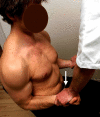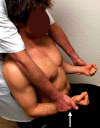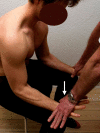Can testing of six individual muscles represent a screening approach to upper limb neuropathic conditions?
- PMID: 24767511
- PMCID: PMC4006451
- DOI: 10.1186/1471-2377-14-90
Can testing of six individual muscles represent a screening approach to upper limb neuropathic conditions?
Abstract
Background: It has previously been demonstrated that an extensive upper limb neurological examination of individual muscle function, sensation in homonymous innervated territories, and nerve trunk allodynia is reliable and that the outcome reflects symptoms. Since this approach may appear complicated and time consuming, this study deals with the value of an examination limited to manual testing of only six muscles.
Methods: Two examiners blinded to symptom status performed manual muscle testing of six muscles in 82 upper limbs with or without pain, weakness, and/or numbness/tingling. The six muscles represent three antagonist pairs (pectoralis major/posterior deltoid, biceps/triceps, and radial flexor of wrist/short radial extensor of wrist). The inter-rater reliability of detecting muscular weaknesses and the relation of weakness to the mentioned symptoms were analysed by kappa-statistics.
Results: The two examiners recognized weaknesses in 48 and 55 limbs, respectively, with moderate agreement (median kappa = 0.58). Out of these, 35 and 32 limbs, respectively, were symptomatic. There was good correlation between findings and symptoms for one examiner (kappa = 0.61) and fair correlation for the other one (kappa = 0.33). Both reached high sensitivity (0.92, 0.84) but less satisfactory specificity (0.70, 0.50). Weaknesses agreed upon by the two examiners correlated moderately with symptoms (kappa = 0.57).
Conclusions: Weakness in one or more muscles was present in almost all symptomatic limbs but in many non-symptomatic limbs as well. Manual testing of six muscles may represent a useful screening approach to upper limb neuropathic conditions, but a confirmative diagnosis requires further assessment.
Figures







Similar articles
-
Diagnostic accuracy of the neurological upper limb examination I: inter-rater reproducibility of selected findings and patterns.BMC Neurol. 2006 Feb 16;6:8. doi: 10.1186/1471-2377-6-8. BMC Neurol. 2006. PMID: 16483371 Free PMC article.
-
Diagnostic accuracy of the neurological upper limb examination II: relation to symptoms of patterns of findings.BMC Neurol. 2006 Feb 27;6:10. doi: 10.1186/1471-2377-6-10. BMC Neurol. 2006. PMID: 16504144 Free PMC article.
-
Studies of upper limb pain in occupational medicine, in general practice, and among computer operators .Dan Med J. 2018 Apr;65(4):B5466. Dan Med J. 2018. PMID: 29619928 Review.
-
Manual strength testing in 14 upper limb muscles: a study of inter-rater reliability.Acta Orthop Scand. 2004 Aug;75(4):442-8. doi: 10.1080/00016470410001222-1. Acta Orthop Scand. 2004. PMID: 15370589
-
Functional, motor, and sensory assessment instruments upon nerve repair in adult hands: systematic review of psychometric properties.Syst Rev. 2018 Oct 27;7(1):175. doi: 10.1186/s13643-018-0836-0. Syst Rev. 2018. PMID: 30368253 Free PMC article.
Cited by
-
Clinical neurological examination vs electrophysiological studies: Reflections from experiences in occupational medicine.World J Methodol. 2015 Jun 26;5(2):26-30. doi: 10.5662/wjm.v5.i2.26. eCollection 2015 Jun 26. World J Methodol. 2015. PMID: 26140269 Free PMC article.
-
Brachial plexopathy: a case-control study of the relation to physical exposures at work.J Occup Med Toxicol. 2015 Apr 11;10:14. doi: 10.1186/s12995-015-0054-9. eCollection 2015. J Occup Med Toxicol. 2015. PMID: 25897317 Free PMC article.
References
-
- Palmer K, Cooper C. In: Hunter’s Diseases of Occupations. Baxter P, Adams P, Aw T, Cockcroft A, Harrington J, editor. London: Arnold; 2000. Repeated Movement and Repeated Trauma Affecting the Musculoskeletal Disorders of the Upper Limbs; pp. 453–475.
-
- Hagert C-G, Hagert E. In: Upper Extremity Nerve Repair - Tips and Techniques: A Master Skills Publication. Slutsky DJ, editor. 6300, North River Rd. Suite 600, Rosemont, IL 60018–4256: American Society for Surgery of the Hand; 2008. Manual Muscle Testing - A Clinical Examination Technique for Diagnosing Focal Neuropathies in the Upper Extremity; pp. 451–465.
Publication types
MeSH terms
LinkOut - more resources
Full Text Sources
Other Literature Sources
Medical

